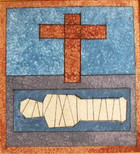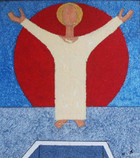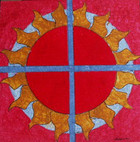William Schickel
(1919-2009)
In the months before his death, William Schickel still observed the Benedictine motto of Ora et Labora (Prayer and Work), writ large on a sign over his workspace in the home of his son, Joseph, in Loveland, Ohio. Before starting his creative labors, the 89-year old artist began each day with prayer. Schickel’s eyesight was failing and his hand less steady, but he never faltered in his lifelong commitment to make art that revealed the sacred in the simple and the ordinary. He was a quiet revolutionary, pursuing his own path.
Before the Second Vatican Council opened the Roman Catholic Church to the contemporary world, Schickel was already using the language of modernism to express the essentials of his faith through art. Rather than make a career for himself in an urban art center, he chose to settle in this rural Ohio community and raise 11 children, living off the land. “It may sound crazy,” Schickel once told me with a laugh, “but the people close to me in art can’t stand my religion, and the people close to me in religion can’t stand my art!”
Schickel described his art as a search for “frugal splendor.” You have only to visit the Grainville Oratory just outside Loveland, which was dedicated in 1962, to understand exactly what he meant. Schickel took an abandoned old barn on the grounds of the Grail community, a Catholic laywoman’s movement to which his wife, Mary, belonged, and turned it into a icon of contemporary sacred architecture. Following his “less is more” aesthetic, he preserved the original wood beams and posts, painted the walls and ceilings an austere white, and opened a well of light above the altar area to create an interior space both spare and luminous.
Schickel applied the same design principles to stained glass windows and baptismal founts, candelabra and baldachins, tabernacles and processional crosses, pulpits and pews, bas-relief wall murals and totem-obelisks. There is little within a church interior that did not undergo his reforming, transforming touch! A mystic with a practical bent, Schickel came up with the idea of making “Icons of the Seasons,” altar paintings in four panels, fitted to a cross, which can be changed and re-arranged according to the seasons and festivals of the church year.
The three Schickel paintings in the Sacred Art Pilgrim Collection, which he completed shortly before his death in 2009, are an off-shoot of this series. Some works of religious art challenge me to take a new look at the biblical narratives by their specificity of detail and exuberance of execution. These figurative abstracts with their economy of form and limited color palette move me in a different way. They inspire contemplation. The Resurrection is, surely, one of the most difficult subjects for an artist to depict, but Schickel succeeds, admirably, in Sonday using just the basic geometric shapes of the circle and square. Schickel had the perfect definition for this kind of sacred art: “visual prayer.”



